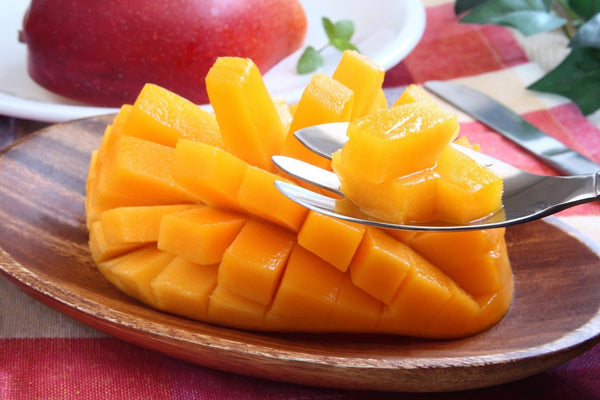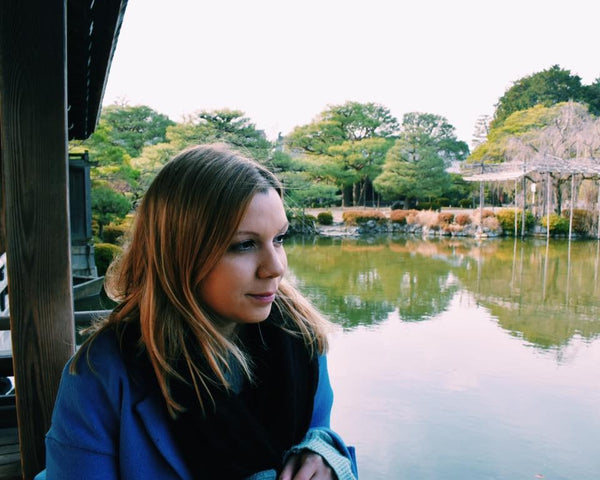Miyazaki Mangoes: The Ultimate Japanese Luxury Fruit

Jump to:
Miyazaki mangoes are cultivated in Miyazaki Prefecture in Kyushu, Japan. Known for their high quality and exceptional taste, they are often referred to as "Taiyo no Tamago" or "Egg of the Sun" due to their bright golden color and juicy, rich flavor.
Miyazaki mangoes are a premium fruit that are highly sought after in Japan and are considered a symbol of luxury. They are typically grown using advanced farming techniques and strict quality control measures, resulting in a fruit that is both visually stunning and incredibly delicious. They are also widely known as being the world’s most expensive mango.
In this article we’ll dive into the Miyazaki mango in more detail and take a look at how they are grown, the Miyazaki mango prices, what makes them so special, and how to enjoy them.
What Is A Miyazaki Mango?

Miyazaki mangoes are harvested every year in Miyazaki Prefecture between April and August. Unlike yellow-skinned mangoes which are common in Southeast Asia, the Miyazaki mango has a red color skin, which is similar to an apple.
Miyazaki mangoes are grown under rigorous standards and have to pass strict controls before they can be distributed for sale. The history of mango growing in Miyazaki is fairly recent, and although mangoes were first introduced to Japan during the Meiji Period (1868-1912), cultivation in Miyazaki didn’t really begin until the 1980s.
Miyazaki has also been a top fruit-producing region in Japan, thanks to its mild climate, with plenty of sunlight and the ideal amount of rainfall, making it the perfect climate for growing citrus fruits such as kumquats and lychees as well as mangoes.
Mangoes first began to be cultivated in the 1980s when a small farm perfected the technique of growing the mangoes in individual nets inside greenhouses and harvesting them when they naturally fell off their branches.
How Are Miyazaki Mangoes Grown?

Miyazaki mangoes are a type of Irwin mango which originated in Florida in the US and is sometimes referred to as an ‘apple mango’ thanks to its red apple-like appearance. Although these types of mangoes can be found in other parts of the world at much lower prices, the care and attention to detail that goes into growing the Miyazaki mango makes it so much more valuable.
For example, the cultivation process typically starts with careful selection of the mango seedlings. Once selected, the seedlings are planted in nutrient-rich soil and placed in greenhouses to protect them from harsh weather conditions and pests.
One way in which the Miyazaki farmers go the extra mile is by renting bees to assist with the pollination of the plants, helping them to grow bigger. There are also other factors at play when it comes to successfully growing Miyazaki mangoes. The temperature in the greenhouse must always be consistent, there needs to be sufficient ventilation, and the air must not be too humid. All these conditions require constant and careful monitoring.
In addition to the strict conditions within the warehouse, each mango must get the correct amount of sunlight exposure to achieve its bright red color and sweet flavor, which requires close monitoring by the farmer to ensure every part of each mango has not fallen into the shade. To promote healthy growth, the mango trees are also pruned regularly and receive regular fertilization and watering.
Once harvested, the mangoes are carefully packaged and transported to market, with strict quality control measures in place to ensure the fruit remains in pristine condition. Throughout the entire cultivation process, attention to detail is key in producing the best possible Miyazaki mangoes.
What Do Miyazaki Mangoes Taste Like?
According to the official Miyazaki Tourism Association – Miyazaki mangoes are completely superior to regular mangoes. They have a creamy texture, fragrant flavor, and juicy flesh. One of the unique characteristics of Miyazaki mangoes is their high sugar content, which gives them their incredibly sweet and rich taste.
What Makes Miyazaki Mangoes So Special?

Whilst all Miyazaki mangoes undergo strict quality controls and conditions, only the very best mangoes can be classified as the highly sought-after ‘Taiyo no Tamago’ mangoes that are auctioned off each April to the highest bidders at the Miyazaki wholesale market. These are the most expensive mangoes in the world.
To qualify as a taiyo no tamago mango, the mangoes must be more than 350 grams in weight, have a sugar content of at least 15%, and be perfect in appearance, shape, and color. The best time to enjoy these special mangoes is between May and June when they are at their most reasonable prices. The cost of taiyo no tamago varies depending on the time of year but it’s not uncommon to see them sold at auction for up to US$4,000 a pair!
These exceptional mangoes are popular to purchase as presents and are part of Japan’s luxury fruit and fruit-giving gift culture. There are two gift-giving seasons per year – one in winter, and one in summer. Gift-giving is important in developing relationships in Japanese culture and presents are given to express gratitude to anyone from colleagues, bosses, and clients to friends and family.
The idea of offering fruit as a gift can be traced back to Shinto and Buddhist practices that have existed since ancient times, where food offerings are laid out at an altar known as a butsudan in Japanese homes to ancestors, or to Shinto gods during festivals.
You can also find luxury fruit stores throughout Japan where you can purchase expensive fruits such as perfect-looking melons, apples, grapes, and strawberries that fetch a high price tag.
How To Enjoy Miyazaki Mangoes
Here are a few ways Miyazaki mangoes are consumed in Japan:

Eaten fresh – the best way to experience the full flavor of a Miyazaki mango is to savor it fresh and unadorned. Simply peel the skin, slice the fruit, and indulge in its sweet, juicy goodness.

In desserts – Miyazaki mangoes are a popular ingredient in Japanese desserts, including fruit parfaits, custard pudding, and mango cakes. The sweetness of the mango pairs perfectly with creamy custard and other sweet treats.

In savory dishes – Miyazaki mangoes can be used in savory dishes as well. For example, the fruit can be used to add a sweet and tangy flavor to mango curry, mango pasta, or even mango salad.
Can I Buy Miyazaki Mangoes Outside of Japan?
Due to their high demand and limited availability, it is quite difficult to purchase Miyazaki mangoes outside of Japan. Also, due to the cost of shipping, import fees, and taxes, it can increase the price of the mangoes even further.
Japanese Snacks Featuring Miyazaki Mangoes
There are several popular Japanese snacks that also use Miyazaki mangoes to flavor their products including:
Miyazaki Mango Langue de Chat

These cookies produced in Miyazaki Prefecture are a popular ‘omiyage’ souvenir item. Made with fully ripened Miyazaki mangoes that comprise around 1% of the entire volume, these cookies have a light and crispy texture that melts in your mouth. The combination of sweet mango and rich chocolate makes for a truly delightful treat.
Miyazaki Mango KitKat

There is a Japanese KitKat for each prefecture in Japan, and for Miyazaki, it’s no surprise to learn that there is a Miyazaki summer mango-flavored KitKat bar. It’s made with smooth and creamy mango-flavored chocolate which features their signature wafer biscuit inside.
Miyazaki Mango Chewy Candy

Puccho is a popular brand of Japanese candy that features cute fruity characters on its packaging. Their Miyazaki mango-flavored soft milky candies contain juicy gummy bits inside them.
Want to learn more about luxury and expensive fruit in Japan? Check out this article!

0 comments